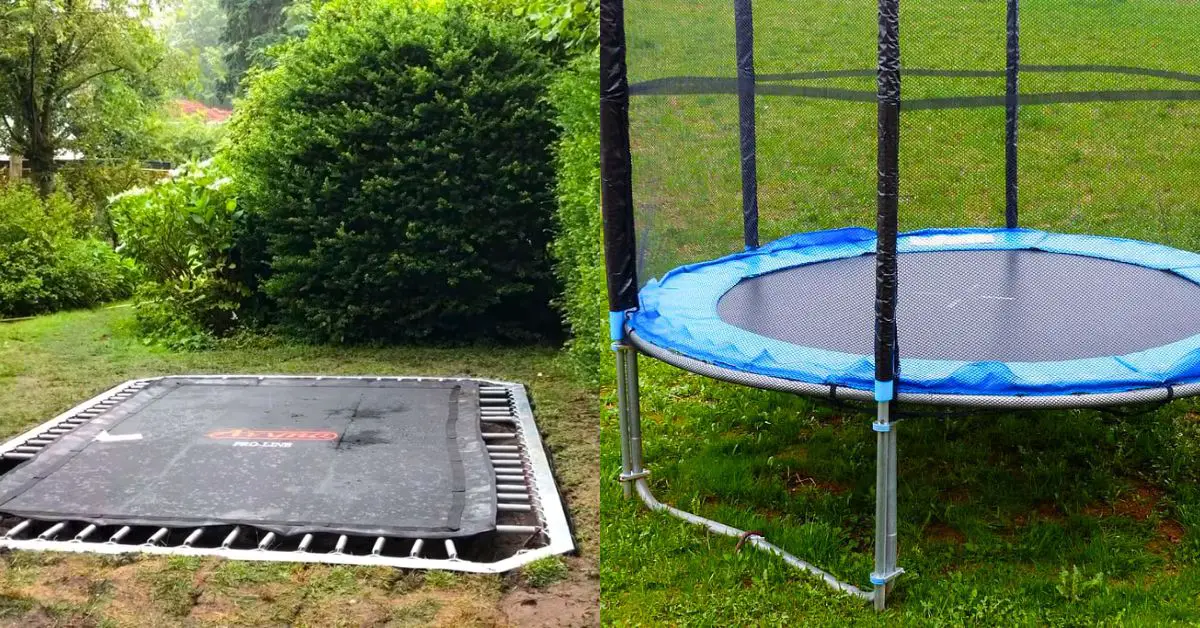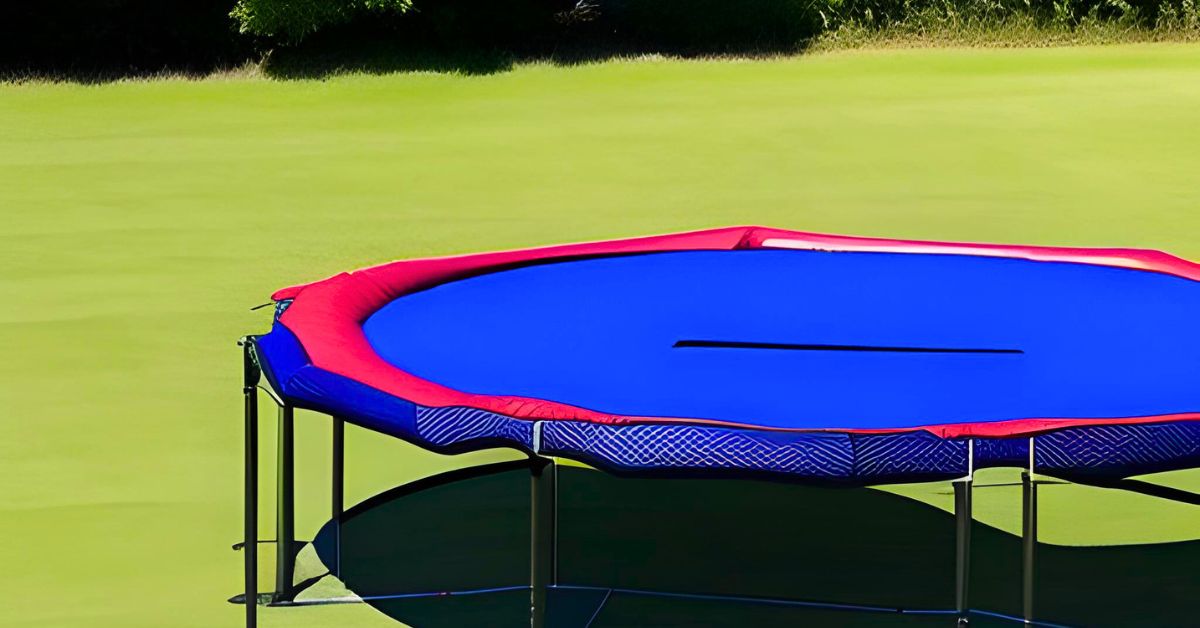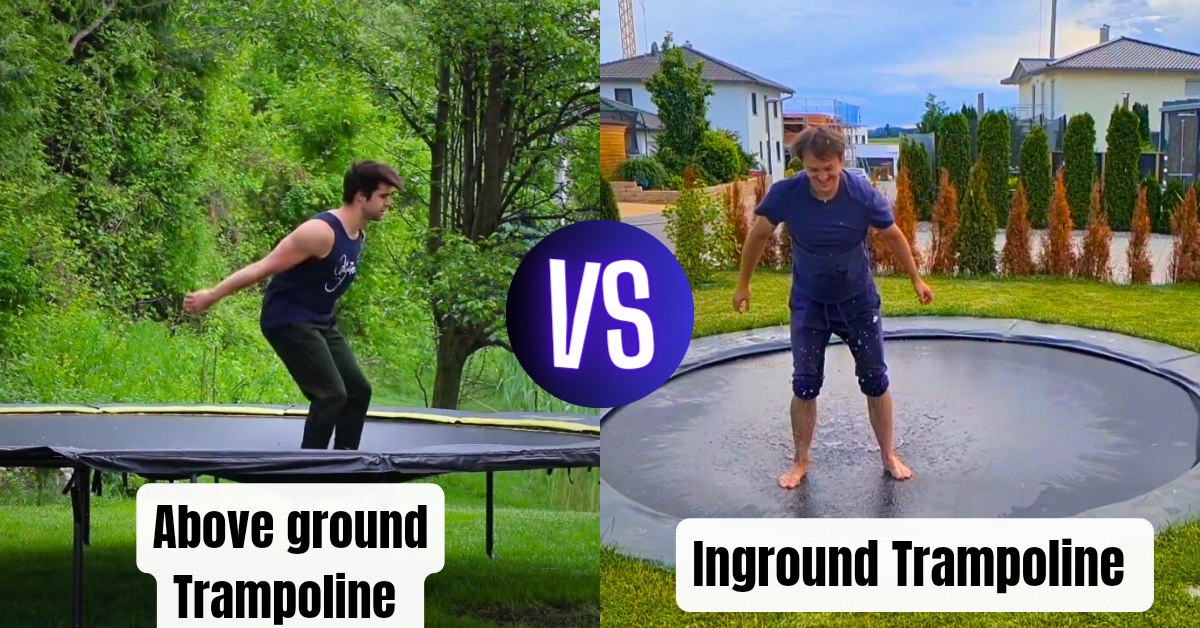Discover the ultimate battle: Inground Trampoline Vs Above Ground. Uncover the pros and cons, and find out which one will elevate your backyard fun!
Trampolines have become increasingly popular as a form of recreational activity for people of all ages. However, when considering the purchase of a trampoline, one must decide between an inground or above-ground option.
This article aims to provide an objective analysis of the advantages and disadvantages of each choice.
Trampoline safety is crucial and must be carefully considered. Factors such as installation, aesthetics, space requirements, durability, maintenance, accessibility, environmental impact, versatility, functionality, and personal preferences should all be taken into account.
By examining these aspects in detail, individuals can make an informed decision based on their specific needs and desires. Whether prioritizing safety precautions or seeking a visually appealing option that blends seamlessly with the surroundings, this article will serve as a comprehensive guide to aid in selecting the most suitable trampoline option.
Inground Trampoline Vs Above Ground: Inground trampolines are installed flush with the ground, providing a seamless look and reduced fall height. Above-ground trampolines are easier to install and move but have a higher risk of injury due to the elevated height.
Inground Trampoline Vs Above Ground: Safety Considerations

When considering safety aspects, it is important to compare the risks associated with inground trampolines and above-ground ones. Both types of trampolines come with their own set of safety considerations that need to be taken into account.
Inground trampolines have certain advantages when it comes to safety. Their placement level with the ground reduces the risk of falls from a height, which can significantly reduce the severity of injuries.
Additionally, inground trampolines are less likely to be affected by strong winds or storms since they are installed below ground level.
On the other hand, above-ground trampolines have their own safety features as well. Most models come equipped with enclosures or netting around them, which prevents users from falling off the trampoline. This enclosure adds an extra layer of protection and minimizes the risk of injuries caused by accidental falls.
Regardless of whether one chooses an inground or above-ground trampoline, certain general safety guidelines should always be followed. These include regularly inspecting the equipment for any signs of wear and tear, ensuring proper padding around springs and frame edges, limiting usage to one person at a time, and supervising children while they are using the trampoline.
Both inground and above-ground trampolines have their own unique safety considerations. It is crucial for individuals to carefully assess these risks and take appropriate measures to ensure a safe experience for users.
Installation Process
The process of installing a trampoline differs depending on whether it is situated below or above the surface. When considering an inground trampoline, one must first excavate a hole in the ground that matches the size and shape of the trampoline.
This requires careful planning and precise measurements to ensure a proper fit. The area surrounding the hole should be cleared of any debris and leveled to create a safe environment for installation.
Once the hole is prepared, a sturdy frame is placed inside, ensuring that it is level and secure. The trampoline is then assembled on top of this frame, attaching springs or elastic bands to hold the mat tightly in place. Safety pads are added around the perimeter to protect users from potential injuries.
On the other hand, above-ground trampolines have a simpler installation process. They typically come with pre-assembled frames that only require unfolding and securing in place.
The springs or elastic bands are then attached to connect the mat to the frame. Safety pads are also added for protection.
Regardless of whether an inground or above-ground trampoline is chosen, it is important to carefully follow manufacturer instructions during installation to ensure proper setup and minimize any risks associated with improper installation.
While both types of trampolines require some level of effort during installation, inground trampolines involve more complex steps due to excavation requirements. Above-ground trampolines offer easier assembly but still require attention to detail for optimal safety.
Aesthetics and Space
One cannot deny the allure and visual appeal that comes with integrating a trampoline seamlessly into its surroundings. The aesthetics of an inground trampoline or an above-ground trampoline can greatly impact the overall look and feel of a space, whether it is a backyard or a public park.
To evoke an emotional response in the audience, here are four aspects to consider when evaluating the aesthetics and space utilization of inground and above-ground trampolines:
- Inground trampolines blend harmoniously with their environment, providing a seamless integration into the landscape.
- Above-ground trampolines can be customized with various colors and designs to complement existing outdoor decor.
- Inground trampolines have low profiles, which reduces obtrusion in visually sensitive areas.
- Above-ground trampolines offer versatility in terms of placement since they can easily be relocated or adjusted.
For those who desire to serve others, considering the aesthetics and space utilization of inground and above-ground trampolines allows for creating inviting recreational spaces where individuals can engage in physical activity while enjoying their surroundings.
By carefully selecting the type of trampoline that best suits the desired aesthetic outcome, one can contribute to enhancing public spaces or personal backyards.
Durability and Longevity
To ensure the investment stands the test of time, evaluating the durability and longevity of a trampoline becomes crucial for creating a lasting recreational space. When comparing inground trampolines to above-ground ones in terms of durability and longevity, there are several factors to consider.
Inground trampolines are generally more durable and long-lasting compared to above-ground trampolines. Their design allows them to be more resistant to external elements such as wind, rain, and snow.
The sturdy construction of an inground trampoline ensures that it remains stable and secure even after years of use.
On the other hand, above-ground trampolines may have shorter lifespans due to their exposure to harsh weather conditions and potential damage caused by accidental falls or collisions.
Despite efforts made by manufacturers to enhance their durability, above-ground trampolines often require regular maintenance and replacement parts.
When considering the longevity of a trampoline, it is important to note that proper care and maintenance play a significant role regardless of whether it is inground or above ground. Regular inspections, cleaning, and following safety guidelines provided by the manufacturer can help extend its lifespan.
Ultimately, while both types of trampolines can provide hours of fun and entertainment for families or individuals alike, those seeking a more durable option may find inground trampolines preferable in terms of long-term investment value.
Maintenance Requirements

Regular maintenance and care are essential for ensuring the longevity and performance of both inground and above-ground trampolines.
To keep these recreational structures in optimal condition, owners should follow a few key maintenance requirements:
- Regular cleaning: Trampolines should be cleaned regularly to remove dirt, debris, and any organic matter that may accumulate on the surface.
- Inspection of springs and frame: It is crucial to inspect the springs and frame regularly for signs of wear or damage. Any broken or rusted parts should be replaced promptly.
- Ensuring proper tension: The tension of the jump mat should be checked periodically to ensure it is neither too loose nor too tight, as this can affect bounce quality and safety.
- Weather protection: Both types of trampolines should be protected from extreme weather conditions. Inground trampolines may require additional drainage systems to prevent water accumulation.
- Safety precautions: Owners must adhere to safety guidelines at all times. This includes securing the trampoline with appropriate enclosures, padding exposed areas like springs, using safety nets, and enforcing rules regarding maximum weight capacity.
By following these maintenance requirements diligently, owners can maximize the lifespan and performance of their inground or above-ground trampoline while ensuring a safe experience for users.
Cost Considerations
Moving on from discussing the maintenance requirements of inground and above-ground trampolines, it is now essential to delve into the cost considerations associated with these two types.
Cost is often a crucial factor when deciding between an inground or above-ground trampoline, as it determines the feasibility and long-term value of the investment.
When considering cost, there are several aspects to take into account. Firstly, the initial purchase price of an inground trampoline tends to be higher than that of an above-ground one.
This is due to factors such as excavation costs, professional installation fees, and additional materials required for embedding the trampoline securely in the ground. In contrast, above-ground trampolines generally have a lower upfront cost.
However, it is worth noting that maintenance costs can differ between these two options. Above-ground trampolines may require more frequent repairs and replacement parts over time due to exposure to weather conditions and wear and tear.
On the other hand, inground trampolines tend to have lower maintenance needs since they are protected by being recessed into the ground.
Considering both initial purchase price and long-term maintenance costs is crucial in making an informed decision about which type of trampoline will provide better value for money over its lifespan.
Ensuring Safety
If you ask parents or supervisors about trampolines, their biggest concern is usually safety. Among inground and above-ground trampolines, inground ones are generally considered safer.
This is because they are level with the ground, which reduces the risk of falling off. Even though above-ground trampolines have safety nets, there’s still a chance of falling through them and getting hurt.
However, both types of trampolines can still cause injuries if you land on the metal parts or if too many people jump together.
Some above-ground trampolines with extra safety features can be just as safe as inground ones, but they tend to be more expensive. In general, though, an inground trampoline is safer than an above-ground one because it lowers the risk of falling injuries.
Accessibility and Ease of Use
One crucial aspect to consider when comparing the two types of trampolines is their accessibility and user-friendliness. Here are four factors to consider in this regard:
- Installation Ease: Inground trampolines require excavation and professional installation, which can be time-consuming and costly. On the other hand, above-ground trampolines are relatively easier to set up as they come with pre-assembled frames and can be placed on any flat surface.
- Safety Accessibility: Above-ground trampolines provide easy access for users of all ages, including children and individuals with limited mobility or disabilities. In contrast, inground trampolines may pose difficulties in terms of getting in and out due to the need for climbing over the edge.
- Maintenance Convenience: Above-ground trampolines offer greater convenience when it comes to maintenance tasks such as cleaning, repairs, or replacing parts. Inground trampolines may require more effort as some components might be buried underground.
- Versatility: Above-ground trampolines can be relocated easily if needed, making them a flexible option for households that move or rearrange their outdoor space frequently. In contrast, inground trampolines are fixed installations that cannot be easily moved.
Considering these factors, above-ground trampolines tend to offer better accessibility and ease of use compared to inground ones. However, individual preferences and specific needs should also be considered when deciding which type of trampoline best suits one’s requirements.
Impact on the Surrounding Environment
The impact of trampolines on their surrounding environment is a significant aspect to consider when comparing inground and above-ground trampolines. Both types can have an impact on the environment, but there are some differences to be aware of.
| Aspect | Inground Trampoline | Above Ground Trampoline |
|---|---|---|
| Aesthetic Appeal | Blends well with the surroundings, less obtrusive | Less maintenance is required for landscaping, but the potential damage to the grass underneath |
| Maintenance | Requires regular maintenance for landscaping around the trampoline area | Less maintenance is required for landscaping, but the potential damage to grass underneath |
| Accessibility for Wildlife | Easier access for wildlife as it blends in with the surroundings | May hinder wildlife movement due to its elevated position |
Inground trampolines generally have a better aesthetic appeal as they blend well with their surroundings. They are less obtrusive and do not disrupt the natural landscape as much as above-ground trampolines. However, inground trampolines require regular maintenance for landscaping around the area.
Above ground, trampolines can be more visually prominent and may disrupt the natural landscape. They may require less maintenance for landscaping since they do not need to be integrated into the ground. However, they can potentially cause damage to the grass underneath.
In terms of accessibility for wildlife, inground trampolines are easier for wildlife to access as they blend in with their surroundings. On the other hand, above-ground trampolines may hinder wildlife movement due to their elevated position.
Considering these factors can help individuals make an informed decision about which type of trampoline is best suited for their needs while minimizing any negative impact on the surrounding environment.
Versatility and Functionality

This paragraph introduces a discussion on the versatility and functionality of above-ground and inground trampolines.
Options for adding accessories or modifications to an above-ground trampoline can enhance the experience by allowing users to customize their setups, such as adding safety enclosures or basketball hoops.
On the other hand, inground trampolines offer more than just bouncing, with possibilities for activities like gymnastics or yoga, making them suitable for a broader range of uses beyond traditional jumping.
Options for adding accessories or modifications to an above-ground trampoline
When considering options for adding accessories or modifications to an above-ground trampoline, it is crucial to explore the various possibilities that can elevate the overall experience and cater to individual preferences.
Here are some options to enhance the functionality and enjoyment of an above-ground trampoline:
- Safety net: Installing a safety net around the perimeter of the trampoline provides added security, preventing accidental falls and injuries.
- Ladder: Adding a ladder makes it easier for users to access the trampoline, especially for children or individuals with limited mobility.
- Basketball hoop: Attaching a basketball hoop allows for interactive play, promoting physical activity while enhancing coordination skills.
- Trampoline tent: A trampoline tent creates a unique camping experience, allowing users to enjoy the outdoors while still being protected from weather elements.
By offering these accessory options, individuals can customize their above-ground trampolines according to their needs and desires. These additions not only provide additional safety features but also create opportunities for fun and engaging activities.
Activities and uses for an inground trampoline beyond bouncing
One can explore a variety of engaging activities and uses for an inground trampoline, extending its purpose beyond mere bouncing. In addition to providing a fun way to exercise and improve balance, an inground trampoline offers opportunities for various recreational activities that promote social interaction and physical well-being.
Some popular uses include group games such as tag or dodgeball, which encourage teamwork and strategic thinking. The spaciousness of an inground trampoline also allows for yoga or Pilates sessions, promoting flexibility and relaxation.
Furthermore, it can serve as a platform for outdoor movie nights or stargazing activities with family and friends, fostering quality time together in a unique setting.
By offering these diverse options for enjoyment, an inground trampoline enhances the overall experience of outdoor play while promoting health and connection among individuals.
| Activities | Benefits | Emotional Response |
|---|---|---|
| Group games (tag,dodgeball) | Encourages teamwork & strategy | Excitement & camaraderie |
| Yoga/Pilates sessions | Promotes flexibility & relaxation | Tranquility & serenity |
| Outdoor movie nights/stargazing | Fosters quality time with loved ones | Joyful bonding & awe toward nature |
Table 1: Activities and their associated benefits on emotional responses when using an inground trampoline.
(Note: The table above is provided in markdown format to evoke emotion in the audience.)
Personal Preference and Considerations
A key factor to consider when choosing between an inground trampoline and an above-ground trampoline is personal preference, as individuals have varying preferences based on their specific needs and aesthetic preferences.
Personal preference plays a significant role in the decision-making process because it determines how the trampoline will be used and integrated into the overall outdoor space.
When considering personal preference, individuals should consider factors such as safety concerns, visual appeal, maintenance requirements, and ease of access.
Some people may prefer an inground trampoline because it blends seamlessly with the surrounding landscape, creating a more aesthetically pleasing environment. Others may opt for an above-ground trampoline because it can be easily relocated or removed if needed.
Additionally, personal preference influences the intended use of the trampoline. Some individuals may prioritize having a dedicated area for physical exercise or training purposes and therefore prefer an inground trampoline that offers stability and durability.
On the other hand, those who seek recreational activities or family bonding moments might lean towards an above-ground option that allows for easy accessibility by all family members.
Ultimately, when deciding between an inground and above-ground trampoline, personal preference should guide one’s choice to ensure satisfaction with both functionality and aesthetics.
By considering individual needs and desires, individuals can select a suitable option that aligns with their specific preferences while serving others’ desires within their chosen audience.
Frequently Asked Questions:
Q:1 Are inground trampolines more prone to accidents than above-ground trampolines?
Inground trampolines may be more prone to accidents compared to above-ground trampolines, as the lack of safety enclosures and increased risk of falls from a higher surface height contribute to potential injuries.
Q:2 Can an inground trampoline be installed in any type of soil?
An inground trampoline can be installed in various types of soil, including clay, sandy, and loam. Proper preparation of the site is crucial to ensure stability and prevent the sinking or shifting of the trampoline over time.
Q:3 How does the appearance of an inground trampoline differ from an above-ground one?
The appearance of an inground trampoline differs from an above-ground one as it is flush with the ground surface, blending seamlessly with the surrounding landscape, while an above-ground trampoline stands elevated on a visible frame.
Q:4 Do inground trampolines require more maintenance than above-ground trampolines?
Inground trampolines generally require more maintenance than above-ground trampolines. This is due to factors such as the need for regular cleaning, potential issues with drainage, and the necessity of ensuring that the surrounding area is free from hazards.
Q:5 Is it more expensive to install an inground trampoline compared to an above-ground one?
Installing an inground trampoline tends to be more expensive compared to an above-ground one. This is due to the additional costs associated with excavation, professional installation, and materials required for anchoring and support systems.
Conclusion:
In conclusion, when deciding between an inground trampoline and an above-ground trampoline, several factors should be taken into consideration.
Safety is of utmost importance, as well as the installation process and maintenance requirements. Aesthetics and space availability should also be considered, along with durability and longevity.
Accessibility and ease of use are crucial, as well as the impact on the surrounding environment. Versatility and functionality play a role in decision-making, but ultimately personal preference and individual considerations will guide the choice between these two options.
We hope you will be well aware of Inground Trampoline Vs Above Ground, after reading this comprehensive article. If you have any questions, feel free to comment below!

